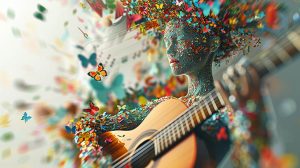
The Benefits of the Ear to Instrument Connection
I recently watched a video performance by the amazing classical pianist Yuja Chang. I’ve seen her memorizing motion and heard her virtuosic playing before, but something hit me after seeing
Categories:
Categories:
This question was asked of me recently by a musician whom I believe is a classical player. It’s a great question, one that I get a lot, and probably on the minds of hundreds of thousands of musicians-jazz or otherwise.
Here’s a sample of comments I’ve received just over the past couple of weeks that are variations on this question:
The musician I mentioned at the top said that he can whistle really well, so why can’t he get that same music through his trombone?
My guess is that he can get music through his trombone without looking at music, but he’s expecting to play things that are either too hard for him right now or songs that he doesn’t truly have in his ear.
He said that he whistles, but how accurate are the pitches? Are they approximate? A sure sign that you aren’t hearing a tune is that you sing or whistle it approximately, not on pitch. You can get away with that when you whistle but not when you play an instrument by ear.
Maybe he is trying to play something he can whistle but it’s too technically hard to play by ear right now. What makes tunes more difficult to play by ear is if they are fast or contain wide intervals.
If that’s the case, play something easier like Mary Had a Little Lamb or Joy to the world. Play it musically and not stiff or boring. If you can’t play even simple music with some life and embellishment in it, you still aren’t really hearing it. (Or your playing is dull. Don’t be dull!)
The other possible cause for not being able to play by ear is that he is not close enough to his trombone. By “close” I mean hearing the trombone well enough to have a certain feel for where the notes are. I believe the goal is to find the notes on your instrument as easily as you find them with your voice.
My Deep Listening workshop is based on demonstrating examples of being close to one’s instrument and how to practice so that you build that mind/instrument connection as fast as possible.
I gave this workshop in the recent Learn Jazz Live event from learnjazzstandards.com.
I’ll share the link to the workshop, but first, I want to give you one tip I demonstrated in the workshop which people really liked. It’s a simple ear-training exercise you can do on your own three minutes each day.
Finding on your instrument what you sang is much harder but that’s where the gold is.
That’s the exercise. Do it for just three minutes each day no matter what. I promise you that in 30 days, you will improvise better and with much more satisfaction. And you won’t say that you can only play what’s on the printed page.
If after doing this for 30 days, you don’t hear the improvement, write me and let me know your experience.
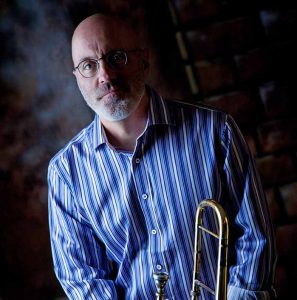
Trombonist, author, marketer, & tech guy
Share this post…

I recently watched a video performance by the amazing classical pianist Yuja Chang. I’ve seen her memorizing motion and heard her virtuosic playing before, but something hit me after seeing

I have created a AI chatbot called Jazz Master Chat that draws from 75 hours of interviews from my Jazz Master Summit event a couple of years ago. I interviewed
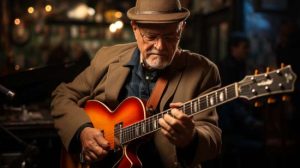
What is jazz improvisation? Let’s first define what I mean by jazz improvisation. Jazz improvisation is a spontaneous conversation, but instead of words, we use notes. Look at two possible

My recently turned 18-year old son is a passionate photographer. He’s got himself a little business where people pay

A couple weeks ago I sent Richie Beirach a YouTube clip from the movie Whiplash as a bit of
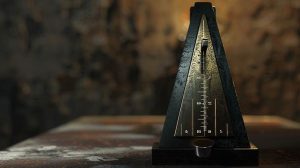
I originally meant to write this as a reply to a comment Richie Beirach wrote on my blog. But
Tools for helping musicians at all levels learn about jazz and play to their full capability.
Web design and marketing by:
Michael Lake @JazzDigitalMarketing.com
This is just a fake book example for the type of website I can build for you. Just trying to use a little humor here!
5 thoughts on “Why can you only play music that’s written on the page?”
Is this workshop good for beginners?
ESPECIALLY for beginners.
If I were learning a new instrument, one of the first things I would practice would be to connect my musical mind to the sound of that instrument. I would use a track of random pitches, then sing them and next find them on my instrument. In my humble opinion, a problem with music education is that it is predominantly focused on using one’s eyes to read the black dots rather than one’s ear to hear the music. My 8-year-old musical self would have so much better off if part of my lessons with my “church lady” piano teacher had included playing notes for me and asking basic questions like is the second note higher or lower? Or is that minor or major chord (“happy or sad feeling”). Or, “Michael, can you sing this note?.” “Michael, can you sing these two notes that I’m playing together?”
Here’s a track of random pitches. If they are too fast or difficult to find on your instrument, sing them first, then pause the recording until you find it on your instrument.
https://soundcloud.com/mlake/miscellaneous-random-timbres?in=mlake/sets/trombone-improvisation-book
I think this is spot on! and number one in importance -thanks for the video.
I love to use analogy : Michael -I hope you like this:
Having all the jazz theory knowledge thoroughly learned might be like having a brand new car fully loaded with every accessory. A strong, well developed sense of relative pitch is like gas in the tank. Without gas in the tank(as an improvisor) you’re not going anywhere!
I like the analogy. I’d add to that brand new car a strong technical facility and command of one’s inbstrument.
I like this exercise in many new ways. I play tenor trombone. It has an infinitely variable tuning slide so matching any pitch is easier than pressing a key pad or valve on a brass instrument or woodwind. The pitch may not be a “true note”…just a pitch (frequency). The fun is trying to match the pitch as close as possible ‘the first time’. So I picked up an alto sax to try the same exercise. Completely different “machine”. I don’t play sax so matching a pitch/note is painful, but I get there and I have to use a ‘fingering chart’…without looking at the written notes. I learn a new fingering and a new pitch all without knowing the associated black dot. Ear/hand/a lot of ear/a lot more hand/then mind. This experiment is forcing me away from the written page by placing me way out of my comfort zone. Trombone improv is taking shape in a different way and I’m learning a new instrument.